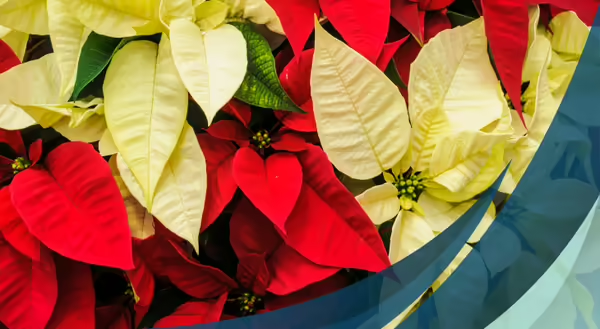
December showers may not bring holiday flowers in Illinois, but houseguests, neighbors, and friends just might! One of the most recognizable of these gift plants is the Poinsettia (Euphorbia pulcherrima).
A native to Mexico, the English-known Poinsettia was known to the Nahuatl and Aztecs as Cuetlaxóchitl, meaning “a flower that withers.” It was cultivated for medicine from the milky sap and for dye from the colorful bracts. (Bracts are the modified, colored leaves that some think of as flowers.) In their native habitat, Poinsettias grow to be 12 to 15 feet tall compared to the modern potted varieties we see today.
Poinsettias were introduced to the United States in 1828 by Joel Roberts Poinsett, the first U.S. Ambassador to Mexico and an American botany enthusiast. After being in Taxco, Guerrero, he brought them to his home in South Carolina. He shared them with horticultural friends and botanical gardens beginning their global popularization.
Poinsettia’s colorful top leaves, or bracts, change from green to shades of red, white, pink, gold, or even marbled. This is triggered by the short days and long nights of winter. They are known for these colorful bracts and not for their small yellow flowers. The lower leaves remain dark green in contrast to their top bracts.
Help Poinsettias last longer
Initially Poinsettias lasted only a few days in a home, but now through cultivation, they can last the holiday season, or longer, depending on care. The Ecke family of California has been instrumental in the development of today's Poinsettia.
When choosing your Poinsettia plant to give or display:
-
Select a plant that has little or no pollen showing in the greenish-yellow inner flowers. Once all the pollen is shed, Poinsettias will drop their bracts and leaves.
-
Wrap your Poinsettia for transport, as cold temperatures can cause damage.
When displaying and caring for your Poinsettia:
-
Keep it away from pets and anyone with a latex allergy, as poinsettias may ooze a milky sap that may cause mild reaction.
-
Keep plants in indirect sunlight for 6 hours and make sure they are not touching windows.
-
Poinsettias should have daytime temperatures ranging from 60°F to 70°F and nighttime temperatures around 55°F. If needed, move the plant into a cooler room during the night.
-
Water only when the soil is dry. Poinsettias often come wrapped in foil or plastic, so poke holes in the bottom so water can drain out. Waterlogged soil can lead to root rot and premature death.
-
Once half of the leaves and bracts have been dropped by the plant, decrease watering until the soil is completely dry.
-
This will cause the plant to go dormant. While the plant is dormant store it in a cool, dark location and only water enough to prevent the stems from shriveling.
-
Most people dispose of their Poinsettias after they finish blooming, but it is possible to get it to bloom again next year.
For more information about care and selection, download our print-friendly infosheet about Poinsettias, or reach out to your local extension office. For more information on the history of Poinsettias, visit the Library of Congress.